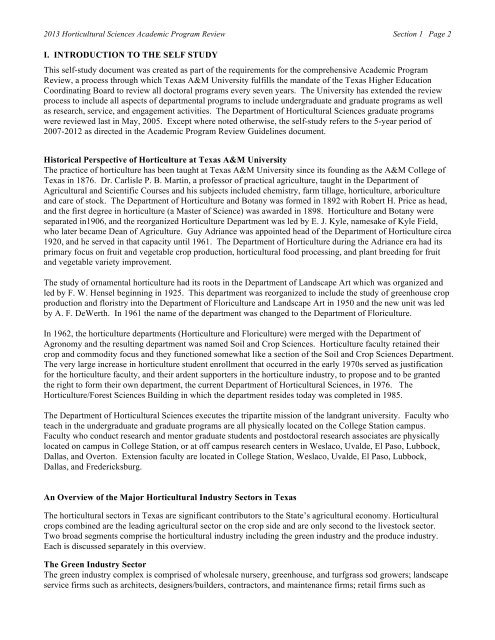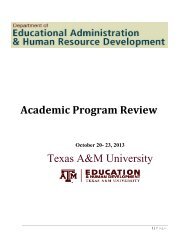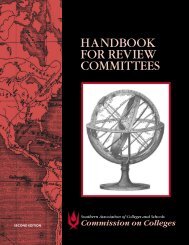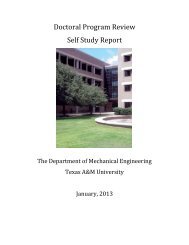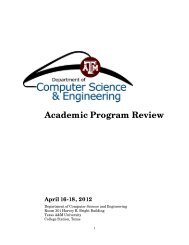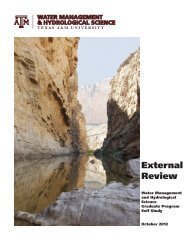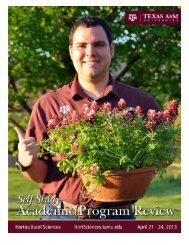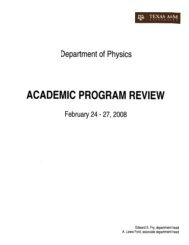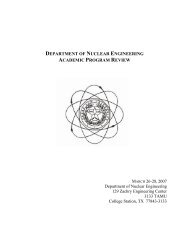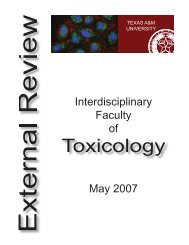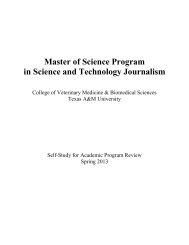its - Office of the Provost and Executive Vice President for Academic ...
its - Office of the Provost and Executive Vice President for Academic ...
its - Office of the Provost and Executive Vice President for Academic ...
You also want an ePaper? Increase the reach of your titles
YUMPU automatically turns print PDFs into web optimized ePapers that Google loves.
2013 Horticultural Sciences <strong>Academic</strong> Program Review Section 1 Page 2<br />
I. INTRODUCTION TO THE SELF STUDY<br />
This self-study document was created as part <strong>of</strong> <strong>the</strong> requirements <strong>for</strong> <strong>the</strong> comprehensive <strong>Academic</strong> Program<br />
Review, a process through which Texas A&M University fulfills <strong>the</strong> m<strong>and</strong>ate <strong>of</strong> <strong>the</strong> Texas Higher Education<br />
Coordinating Board to review all doctoral programs every seven years. The University has extended <strong>the</strong> review<br />
process to include all aspects <strong>of</strong> departmental programs to include undergraduate <strong>and</strong> graduate programs as well<br />
as research, service, <strong>and</strong> engagement activities. The Department <strong>of</strong> Horticultural Sciences graduate programs<br />
were reviewed last in May, 2005. Except where noted o<strong>the</strong>rwise, <strong>the</strong> self-study refers to <strong>the</strong> 5-year period <strong>of</strong><br />
2007-2012 as directed in <strong>the</strong> <strong>Academic</strong> Program Review Guidelines document.<br />
Historical Perspective <strong>of</strong> Horticulture at Texas A&M University<br />
The practice <strong>of</strong> horticulture has been taught at Texas A&M University since <strong>its</strong> founding as <strong>the</strong> A&M College <strong>of</strong><br />
Texas in 1876. Dr. Carlisle P. B. Martin, a pr<strong>of</strong>essor <strong>of</strong> practical agriculture, taught in <strong>the</strong> Department <strong>of</strong><br />
Agricultural <strong>and</strong> Scientific Courses <strong>and</strong> his subjects included chemistry, farm tillage, horticulture, arboriculture<br />
<strong>and</strong> care <strong>of</strong> stock. The Department <strong>of</strong> Horticulture <strong>and</strong> Botany was <strong>for</strong>med in 1892 with Robert H. Price as head,<br />
<strong>and</strong> <strong>the</strong> first degree in horticulture (a Master <strong>of</strong> Science) was awarded in 1898. Horticulture <strong>and</strong> Botany were<br />
separated in1906, <strong>and</strong> <strong>the</strong> reorganized Horticulture Department was led by E. J. Kyle, namesake <strong>of</strong> Kyle Field,<br />
who later became Dean <strong>of</strong> Agriculture. Guy Adriance was appointed head <strong>of</strong> <strong>the</strong> Department <strong>of</strong> Horticulture circa<br />
1920, <strong>and</strong> he served in that capacity until 1961. The Department <strong>of</strong> Horticulture during <strong>the</strong> Adriance era had <strong>its</strong><br />
primary focus on fruit <strong>and</strong> vegetable crop production, horticultural food processing, <strong>and</strong> plant breeding <strong>for</strong> fruit<br />
<strong>and</strong> vegetable variety improvement.<br />
The study <strong>of</strong> ornamental horticulture had <strong>its</strong> roots in <strong>the</strong> Department <strong>of</strong> L<strong>and</strong>scape Art which was organized <strong>and</strong><br />
led by F. W. Hensel beginning in 1925. This department was reorganized to include <strong>the</strong> study <strong>of</strong> greenhouse crop<br />
production <strong>and</strong> floristry into <strong>the</strong> Department <strong>of</strong> Floriculture <strong>and</strong> L<strong>and</strong>scape Art in 1950 <strong>and</strong> <strong>the</strong> new unit was led<br />
by A. F. DeWerth. In 1961 <strong>the</strong> name <strong>of</strong> <strong>the</strong> department was changed to <strong>the</strong> Department <strong>of</strong> Floriculture.<br />
In 1962, <strong>the</strong> horticulture departments (Horticulture <strong>and</strong> Floriculture) were merged with <strong>the</strong> Department <strong>of</strong><br />
Agronomy <strong>and</strong> <strong>the</strong> resulting department was named Soil <strong>and</strong> Crop Sciences. Horticulture faculty retained <strong>the</strong>ir<br />
crop <strong>and</strong> commodity focus <strong>and</strong> <strong>the</strong>y functioned somewhat like a section <strong>of</strong> <strong>the</strong> Soil <strong>and</strong> Crop Sciences Department.<br />
The very large increase in horticulture student enrollment that occurred in <strong>the</strong> early 1970s served as justification<br />
<strong>for</strong> <strong>the</strong> horticulture faculty, <strong>and</strong> <strong>the</strong>ir ardent supporters in <strong>the</strong> horticulture industry, to propose <strong>and</strong> to be granted<br />
<strong>the</strong> right to <strong>for</strong>m <strong>the</strong>ir own department, <strong>the</strong> current Department <strong>of</strong> Horticultural Sciences, in 1976. The<br />
Horticulture/Forest Sciences Building in which <strong>the</strong> department resides today was completed in 1985.<br />
The Department <strong>of</strong> Horticultural Sciences executes <strong>the</strong> tripartite mission <strong>of</strong> <strong>the</strong> l<strong>and</strong>grant university. Faculty who<br />
teach in <strong>the</strong> undergraduate <strong>and</strong> graduate programs are all physically located on <strong>the</strong> College Station campus.<br />
Faculty who conduct research <strong>and</strong> mentor graduate students <strong>and</strong> postdoctoral research associates are physically<br />
located on campus in College Station, or at <strong>of</strong>f campus research centers in Weslaco, Uvalde, El Paso, Lubbock,<br />
Dallas, <strong>and</strong> Overton. Extension faculty are located in College Station, Weslaco, Uvalde, El Paso, Lubbock,<br />
Dallas, <strong>and</strong> Fredericksburg.<br />
An Overview <strong>of</strong> <strong>the</strong> Major Horticultural Industry Sectors in Texas<br />
The horticultural sectors in Texas are significant contributors to <strong>the</strong> State’s agricultural economy. Horticultural<br />
crops combined are <strong>the</strong> leading agricultural sector on <strong>the</strong> crop side <strong>and</strong> are only second to <strong>the</strong> livestock sector.<br />
Two broad segments comprise <strong>the</strong> horticultural industry including <strong>the</strong> green industry <strong>and</strong> <strong>the</strong> produce industry.<br />
Each is discussed separately in this overview.<br />
The Green Industry Sector<br />
The green industry complex is comprised <strong>of</strong> wholesale nursery, greenhouse, <strong>and</strong> turfgrass sod growers; l<strong>and</strong>scape<br />
service firms such as architects, designers/builders, contractors, <strong>and</strong> maintenance firms; retail firms such as


